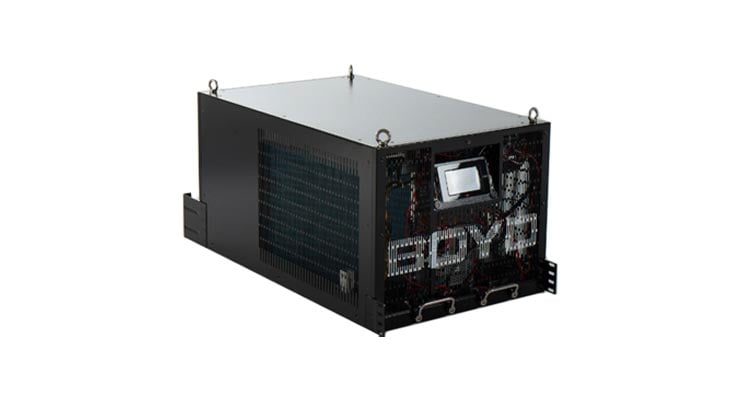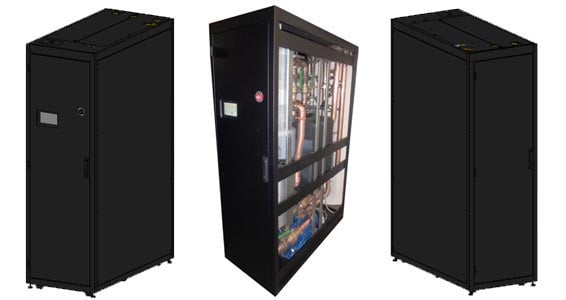IT 냉각 마스터하기: 액체 냉각 솔루션의 힘
데이터 센터 인프라 관리(DCIM)에 대한 수요가 계속 증가함에 따라 열이라는 골치 아픈 문제가 발생하고 있습니다. 기존의 공랭식 냉각은 속도를 따라잡기 위해 고군분투하고 있으며, 이는 데이터 센터 성능과 장비 수명을 위협하고 있습니다. 액체 냉각은 향상된 효율성과 더 높은 냉각 용량을 갖춘 최신 데이터 센터에 가장 효과적인 솔루션입니다. 고출력 CPU, GPU 및 네트워크 스위치를 열 사양 내에서 유지하기 위해 냉각수 분배 장치(CDU)는 기존 공랭식보다 효율성과 유연성을 높이기 위해 열원과 직접 열적으로 인터페이스하는 액체 냉각 루프 및 냉각판에 더 넓은 냉각 용량을 제공합니다.
냉각수 분배 서비스를 요청하셨습니까?

데이터 센터 냉각 시스템 시장의 미래
데이터 센터 냉각 시장은 2024-2030 예측 기간 동안 13.8%의 CAGR로 성장하여 2030년까지 101억 1천만 달러에 이를 것으로 예상되며 업계는 현대 데이터 센터의 증가하는 냉각 수요를 충족하기 위해 액체 냉각 솔루션으로의 상당한 전환을 목격하고 있습니다. 글로벌 데이터 센터 액체 냉각 시장은 2024에서 2029까지 23.31% CAGR로 성장할 것으로 예상됩니다. Boyd는 이러한 액체 냉각 시스템을 최적화하기 위해 CDU를 설계하여 데이터 센터에서 정밀한 온도 제어와 효율적인 열 제거를 보장합니다.CDU란?
냉각수 분배 장치(CDU) 또는 냉각 분배 장치는 고성능 환경 내에서 정밀한 열 관리를 조정합니다. 냉각수 분배 장치는 냉각수 또는 기타 유체를 액체 냉각이 필요한 기계 또는 공정의 다양한 구성 요소에 능동적으로 분배합니다. 이 공정은 액체 냉각수가 액체 냉각판 또는 액체 냉각 루프라고 하는 일련의 냉각판을 통해 고출력 장비의 열을 흡수하는 것으로 시작됩니다. 그런 다음 가열된 냉각수는 구성에 따라 CDU 내부 또는 외부의 열 교환 기술을 통해 흐르며 열을 발산합니다. 일반적으로 대규모 데이터 센터 인프라, 데이터 센터 랙, 실험실 및 반도체 제조 공장에 통합되는 CDU는 데이터 센터, 산업 환경 및 정밀한 온도 제어가 중요한 기타 환경에서 최적의 작동 조건을 유지하는 데 필수적입니다. CDU는 한 차원 높은 성능의 냉각이 시스템 구성 요소 및 열원에 효율적이고 안전하게 전달되도록 보장하여 과열을 방지하고 성능과 수명을 최적화합니다.


CDU는 어떻게 작동하나요?
냉각수 분배 장치(CDU)는 복잡한 파이프 또는 채널 네트워크를 통해 냉각수(일반적으로 물 또는 특수 유체)를 순환시키는 정교한 펌프 시스템을 통해 작동합니다. 열 방출에 필수적인 이 순환 냉각수는 대규모 고전력 데이터 센터 시스템의 프로세서 및 스위치와 같은 중요한 구성 요소를 대상으로 합니다. CDU는 밸브, 필터 및 모니터링 메커니즘과 같은 추가 구성 요소를 통합하여 냉각 효율성과 시스템 신뢰성을 최적화합니다. 정밀하게 보정된 밸브를 통해 개별 구성품 요구 사항에 맞게 냉각수 분배를 동적으로 조정할 수 있으며, 필터는 불순물과 오염 물질을 걸러내어 순도를 보장합니다. 센서가 장착된 CDU는 온도, 유량 및 압력 수준과 같은 냉각수 매개변수를 지속적으로 모니터링하여 복잡한 환경에서 최고의 열 성능과 신뢰성을 유지하기 위한 실시간 개입을 가능하게 합니다.CDU에는 어떤 부품이 있습니까?
대부분의 냉각수 분배 장치(CDU)는 펌프, 열교환기, 마이크로프로세서 제어, 수질 관리 시스템 및 냉각수 처리 매니폴드와 같은 공통 구성 요소를 공유하여 다양한 모델에서 일관된 기능을 보장합니다. 이러한 구성 요소는 CDU 시스템의 중추를 형성하여 데이터 센터 및 기타 산업 응용 분야에서 지속 가능한 냉각을 촉진합니다. 민감한 고전력 장비 및 기계를 원활하게 작동하는 데 중요한 고성능 냉각의 복잡한 프로세스를 조율하여 최첨단 엔지니어링 및 기술 혁신을 구현합니다.펌프
펌프는 시스템을 통해 냉각수를 순환시켜 장비에서 열을 흡수하기 위해 액체의 안정적인 흐름을 보장합니다.열 교환기
액체-공기 열교환기는 냉각수에서 주변 환경으로 열을 전달하여 액체가 연결되지 않은 시설의 효율적인 열 방출을 촉진합니다. 액체-액체 열교환기는 1차 액체 루프에서 2차 시설 용수 시스템으로 열을 전달합니다.마이크로프로세서 제어
마이크로프로세서 제어는 CDU 작동을 관리 및 조절하고, 냉각수 유량 및 기타 매개변수를 조정하여 최적의 온도와 성능을 유지하고, 수요를 계산하기 위해 자동으로 조정합니다.수질 관리 시스템
수질 관리 시스템은 냉각수의 순도와 화학적 균형을 모니터링하고 유지하여 부식을 방지하고 장기적인 신뢰성을 유지합니다.절삭유 취급 매니폴드
절삭유 취급 매니폴드는 CDU 시스템 내의 다양한 구성 요소에 절삭유를 분배하여 모든 부품에서 균일한 냉각을 보장합니다. 특정 CDU 모델에는 특정 냉각 요구 사항 또는 환경 문제를 해결하도록 설계된 특수 구성 요소가 통합되어 있습니다. 이러한 구성 요소는 기능을 강화할 뿐만 아니라 광범위한 사용자 요구 사항을 충족하는 고유한 기능을 제공합니다. 정밀하게 설계된 이 특수 요소는 냉각 성능을 최적화하고 다양한 작동 조건에서 원활한 작동을 보장합니다. 원활한 통합과 상호 운용성은 최신 데이터 센터 및 산업 시설의 다양한 냉각 요구 사항과 요구 사항을 충족할 수 있는 CDU 시스템의 적응성을 강조합니다.CDU에는 어떤 유형이 있습니까?

냉각수 분배 장치(CDU)는 데이터 센터 내에서 최적의 온도를 유지하여 서버 및 기타 IT 장비가 효율적으로 작동하도록 합니다. 다양한 유형의 CDU는 다양한 냉각 요구 사항 및 구성을 충족합니다. 주요 유형에는 In-Row, In-Rack, L2A(Liquid to Air), 사이드카 및 L2L(Liquid to Liquid) CDU가 포함됩니다. 각 유형은 특정 냉각 요구 사항에 맞게 조정된 고유한 기능과 응용 프로그램을 제공합니다.
In-Row CDU 또는 사이드카
In-Row CDU는 서버 랙 사이 또는 서버 랙 행 끝에 위치하여 일련의 서버 랙을 냉각합니다. 냉각수 또는 냉매를 사용하여 서버에서 직접 열을 흡수합니다. 냉각된 액체는 2차 냉각측의 폐쇄 루프 시스템에서 순환하고, 1차 방열측에서는 설비 용수를 사용합니다. In Row CDU는 최대 2300KW까지 냉각할 수 있으며 10개의 고전력 서버 랙을 배열할 수 있습니다.


랙 내 CDU
In-Rack CDU는 서버 랙 내에 설치되기 때문에 장비에 고도로 국소화된 냉각을 제공합니다. 이 장치는 액체-액체 또는 액체-공기 냉각을 특징으로 합니다. 수냉식 CDU는 랙 유닛 내의 액체-액체 열교환기를 통해 냉각수를 순환시켜 1차 시설 용수 시스템으로 2차 루프를 냉각합니다. 공랭식 시설의 경우 액체-공기 냉각수 분배 장치는 시설의 차가운 공기에서 끌어와 액체-공기 열교환기를 통해 액체 루프를 냉각하고 가열된 공기를 시설로 배출합니다. In-Rack CDU는 클라우드 데이터 센터 서버 또는 의료 및 산업 모델과 같은 고전력 장치에 원활하게 통합됩니다. 간편한 설치 및 유지 보수로 서버 랙 냉각을 단순화합니다. 이러한 시스템은 표준 서버 구성에 적합하고 독립형 또는 통합 설정을 위한 유연성을 제공하여 비용 효율적이고 안정적인 냉각 업그레이드를 제공합니다.
액체 대 공기(L2A) CDU
L2A(Liquid to Air) CDU는 액체 냉각수(일반적으로 물 또는 물-글리콜 혼합물)의 열을 주변 공기로 효율적으로 전달합니다. 이 프로세스는 액체 냉각수가 액체 냉각판 또는 액체 냉각 루프라고 하는 일련의 냉각판을 통해 데이터 센터 장비의 열을 흡수하는 것으로 시작됩니다. 가열된 냉각수는 CDU 내의 열교환기를 통해 흐르고, 여기서 팬은 열교환기 위로 공기를 불어넣어 열을 발산합니다. L2A CDU는 설비 공조를 활용하여 서버 열에서 열을 발산하여 고출력 데이터 센터 장비를 위한 국부적인 액체 냉각을 가능하게 합니다. 공랭식 데이터 센터의 냉각 잠재력을 극대화하여 열 관리 장비 및 설치 비용을 줄이는 동시에 공기만 사용하는 것보다 더 높은 냉각 용량을 제공합니다. 액체-공기 CDU는 전체 시설의 시스템을 업그레이드할 필요 없이 기존 데이터 센터에 액체 냉각 기술을 도입하기 위한 비용 효율적인 개조로 간주됩니다.







